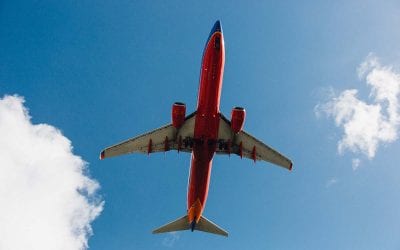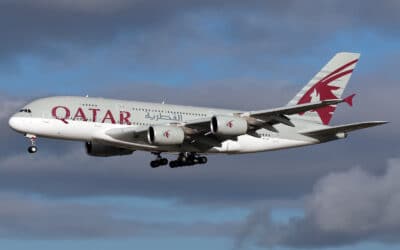After erasing their cockpit voice recorder by flying to their destination, American Airlines pilots are refusing to testify to the NTSB incident investigators following a near fatal incident at JFK.
 On January 13, a near-fatal incident occurred at the John F. Kennedy International Airport (JFK). An American Airlines Boeing 777, flight 106, and a Delta Airlines Boeing 737, flight 1943, nearly collided on a runway on which the Delta jet was taking off. If they collided, it’s likely that 308 passengers and flight crew would have died. The American Airlines pilots are refusing to testify.
On January 13, a near-fatal incident occurred at the John F. Kennedy International Airport (JFK). An American Airlines Boeing 777, flight 106, and a Delta Airlines Boeing 737, flight 1943, nearly collided on a runway on which the Delta jet was taking off. If they collided, it’s likely that 308 passengers and flight crew would have died. The American Airlines pilots are refusing to testify.
Since I wrote about the near collision last month in my column, FAA plane incident data and testimony must be preserved and honest, a new development in the National Transportation Safety Board (NTSB) investigation of the incident has caused me to write about it again. The pilots of the American Airlines plane are currently refusing to testify about the incident because the NTSB wants to record their testimony to ensure its accuracy.
The NTSB needs the recorded testimony of the American pilots because their action caused their cockpit chatter during the incident to be erased.
 This recorded testimony is necessary largely because of the actions of the American pilots themselves. The pilots erased the cockpit recording of what they were saying to each other during the incident. They did it by leaving for their destination, London’s Heathrow Airport, soon after the incident. It’s a seven-hour flight, and cockpit voice recorders write over themselves every two hours.
This recorded testimony is necessary largely because of the actions of the American pilots themselves. The pilots erased the cockpit recording of what they were saying to each other during the incident. They did it by leaving for their destination, London’s Heathrow Airport, soon after the incident. It’s a seven-hour flight, and cockpit voice recorders write over themselves every two hours.
Before discussing the investigation, it’s essential to review what happened during the incident.
At JFK, the American plane was taxiing while the Delta jet was waiting to take off. An air traffic controller told the American 777 to cross Runway 31L to continue on. The Delta flight was on Runway 4L. The American pilot confirmed the instruction. At almost the same time, another air traffic controller told the Delta flight it was cleared for takeoff. The Delta pilot confirmed.
The ground radar recording of the incident shows the American pilots didn’t follow the instructions they confirmed they heard.
With the Delta flight starting their takeoff, according to the ground radar recording, the American 777 went left then right, heading for Runway 4L, instead of turning right as instructed. About 20 seconds later, you can hear in the audio recording the air traffic controller call out to the Delta flight,
“Sh!t! Delta 1943 cancel takeoff clearance. Delta 1943 cancel takeoff clearance.”
Another air traffic controller called the American flight, “American 106 heavy, American 106 heavy, hold position. American 106 heavy, hold position.”
The Delta jet was able to stop 1,000 feet short of where the American jet crossed the runway. A thousand feet (305 meters) sounds like a lot, but it’s a tiny distance on a runway. The Delta plane was at 115 mph (100 knots) and accelerating when the pilots slammed on the brakes. At 115 mph, the Delta jet would travel 1,000 feet in under six seconds.
The catastrophe had been avoided with a mere six seconds to spare.
While the Delta pilots returned to the gate, the American pilots flew their plane to London, which is the crux of the testimony problem.
Following the near-collision, the Delta pilots returned their plane to the gate. The flight was delayed until the next day. After a short delay, the American pilots continued their flight to London. That’s the action that erased the cockpit voice recording of the incident, preventing the NTSB from listening to and scrutinizing the cockpit chatter among the pilots in the American 777 during the incident. While it may be possible, it’s hard to believe that the pilots didn’t know that by flying to London, they would erase the recording of what went on in the cockpit during the incident.
Since the incident, the NTSB has retrieved the black box recordings from both planes and the voice recording from the Delta plane and obtained crew statements. They confirmed that the cockpit voice recording of the incident from the American Airlines plane was “unavailable.” They also confirmed that transcripts of each American flight crew member’s account of the incident were essential in the absence of the voice recording.
The NTSB has tried three times to get the American pilots to testify without getting them to do so.
The NTSB has further confirmed that they attempted to interview the American flight crew on three different occasions but were rebuffed by the pilots each time. On behalf of the pilots, the Allied Pilots Association representing them said,
“We join in the goal of creating an accurate record of all interviews conducted in the course of an investigation. However, we firmly believe the introduction of electronic recording devices into witness interviews is more likely to hinder the investigation process than it is to improve it.”
It’s their contention that by recording the interviews to ensure their accuracy, the pilots will be “less candid,” if they are willing to testify at all under the circumstance.
Does the pilot’s union and position make sense to you? It doesn’t make sense to me unless the pilots plan to later claim, if necessary, that the NTSB investigator didn’t get their story straight and that the NTSB can’t prove otherwise, because there was no recording of their testimony nor a transcription by a court reporter.
This latest twist makes me more adamant that NTSB accident investigation rules need to be substantially beefed up. It is essential that we learn how incidents like this occurred so that similar incidents can be prevented in the future. We need new rules to be in place so that all evidence of any incident can be properly preserved and testimony be accurately obtained and recorded for analysis.
Five new NTSB investigation rules are needed to ensure the agency can properly investigate accidents and incidents.
I propose that NTSB investigation rules include:
1. The flight crew of planes involved in accidents and serious incidents should be detained, if possible, at the site of the incident until they can give their account of the incident to NTSB investigators, unless they need medical treatment or would otherwise put them in danger.
2. At the site of the accident or incident, the detained members of the flight crews should be immediately separated, so that they can’t speak with each other about the accident or incident until after their testimony is taken.
3. If the accident or incident is on the ground, or once a flight has landed after an incident in the air, under no circumstances should the flight crew be permitted to resume their flight duties prior to being interviewed by the NTSB.
4. The planes involved in accidents or incidents should be impounded until examined and released by NTSB investigators with the cockpit voice recordings and flight recordings recovered.
5. All testimony to the NTSB should be recorded to ensure the highest possible accuracy. If necessary, in addition to recording the testimony, a court reporter should transcribe the testimony.
The NTSB issued subpoenas to the American flight crew. Will they comply?
Last Friday, the NTSB confirmed it issued subpoenas to the three American flight crew members who have refused to testify. They have until Friday to respond.
To determine what happens in accidents and incidents, so that they can prevent them in the future, it seems clear to me that the NTSB needs better tools to ensure that all the data about the accidents and incidents is preserved to the extent possible and that they get honest testimony from all parties. At the same time, the information is fresh in their minds. These rules additions can substantially help the NTSB ensure they accomplish their task.

READ ALSO:
The President tees up hotel resort fees and family seating on planes for Congress
Traveling with a child without your surname or have shared custody? Get written parental consent!
After many years working in corporate America as a chemical engineer, executive and eventually CFO of a multinational manufacturer, Ned founded a tech consulting company and later restarted NSL Photography, his photography business. Before entering the corporate world, Ned worked as a Public Health Engineer for the Philadelphia Department of Public Health. As a well known corporate, travel and wildlife photographer, Ned travels the world writing about travel and photography, as well as running photography workshops, seminars and photowalks. Visit Ned’s Photography Blog and Galleries.



